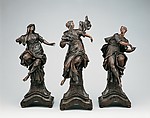Faith, Hope and Charity
Balthasar Ferdinand Moll Austrian
Moll's reputation as a major Austrian sculptor rests mainly on state tombs for the Habsburgs located in the Capuchin church in Vienna. These include one of the most splendid examples of late Baroque sculpture, the double sarcophagus made in 1753–54 for Empress Maria Theresa (d. 1780) and her consort, Francis I of Lorraine (d. 1765). The sculptor's first major project, completed in 1739, was the figurative decoration for the pulpit of the Church of the Servites, Vienna. The Museum's statuettes are small-scale versions of the monumental figures crowning the pulpit: the theological virtues Faith, Love (Charity), and Hope. However, because of the lack of attributes, we can only assume that our figures served as independent works of art rather than as devotional objects. Their style echoes the influence of the Austrian sculptor Georg Raphael Donner (1693–1741). The strongly contrasted forms and the skillfully differentiated finishes of the walnut and dark-stained ivory take advantage of effects of light and shadow and evoke the unifying artificial gallery patina of bronze sculpture of this period. The almost metal-like appearance of the surface tooling demonstrates the artist's virtuosity and may be an early testament to Moll's prominent place in the development of sculptural metal casting in eighteenth-century Vienna.
This image cannot be enlarged, viewed at full screen, or downloaded.


